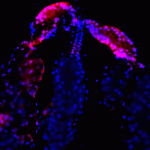Link to Pubmed [PMID] – 29898985
Link to DOI – 10.1128/mSphere.00239-18
mSphere 2018 Jun; 3(3):
The recent emergence of novel tick-borne RNA viruses has complicated the epidemiological landscape of tick-borne infectious diseases, posing a significant challenge to public health systems that seek to counteract tick-borne diseases. The identification of two novel tick-borne phleboviruses (TBPVs), severe fever with thrombocytopenia syndrome virus (SFTSV) and Heartland virus (HRTV), as causative agents of severe illness in humans has accelerated the investigation and discoveries of novel TBPVs. In the present study, we isolated a novel TBPV designated Mukawa virus (MKWV) from host-questing Ixodes persulcatus females captured in Japan. Genetic characterization revealed that MKWV is a member of the genus Phlebovirus in the family Phenuiviridae Interestingly, MKWV is genetically distinct from other known TBPVs and shares a most recent common ancestor with mosquito/sandfly-borne (insect-borne) phleboviruses. Despite its genetic similarity to insect-borne phleboviruses, the molecular footprints of its viral proteins and its biological characteristics define MKWV as a tick-borne virus that can be transmitted to mammals. A phylogenetic ancestral-state reconstruction for arthropod vectors of phleboviruses including MKWV based on viral L segment sequences indicated that ticks likely harbored ancestral phleboviruses that evolved into both the tick-borne and MKWV/insect-borne phlebovirus lineages. Overall, our findings suggest that most of the phlebovirus evolution has occurred in hard ticks to generate divergent viruses, which may provide a seminal foundation for understanding the mechanisms underlying the evolution and emergence of pathogenic phleboviruses, such as Rift Valley fever virus and SFTSV/HRTV.IMPORTANCE The emergence of novel tick-borne RNA viruses causing severe illness in humans has complicated the epidemiological landscape of tick-borne diseases, requiring further investigation to safeguard public health. In the present study, we discovered a novel tick-borne phlebovirus from Ixodes persulcatus ticks in Japan. While its viral RNA genome sequences were similar to those of mosquito/sandfly-borne viruses, molecular and biological footprints confirmed that this is a tick-borne virus. The unique evolutionary position of the virus allowed us to estimate the ancestral phlebovirus vector, which was likely a hard tick. Our findings may provide a better understanding of the evolution and emergence of phleboviruses associated with emerging infectious diseases, such as severe fever with thrombocytopenia syndrome (SFTS) and Heartland virus disease.

